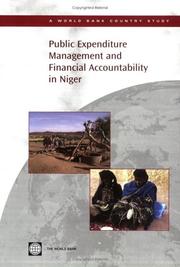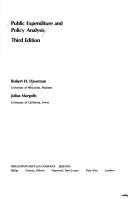| Listing 1 - 10 of 195 | << page >> |
Sort by
|
Periodical
Year: 2001 Publisher: Pretoria : National Treasury,
Abstract | Keywords | Export | Availability | Bookmark
 Loading...
Loading...Choose an application
- Reference Manager
- EndNote
- RefWorks (Direct export to RefWorks)
Budget --- FINANCIAL STATISTICS. --- PUBLIC EXPENDITURES. --- SOUTH AFRICA. --- South Africa --- Appropriations and expenditures
Periodical
Year: 2001 Publisher: Pretoria : National Treasury,
Abstract | Keywords | Export | Availability | Bookmark
 Loading...
Loading...Choose an application
- Reference Manager
- EndNote
- RefWorks (Direct export to RefWorks)
Budget --- FINANCIAL STATISTICS. --- PUBLIC EXPENDITURES. --- SOUTH AFRICA. --- South Africa --- Appropriations and expenditures
Book
Year: 2012 Publisher: Washington, D.C. : The World Bank,
Abstract | Keywords | Export | Availability | Bookmark
 Loading...
Loading...Choose an application
- Reference Manager
- EndNote
- RefWorks (Direct export to RefWorks)
This report analyzes gender dimensions of poverty and shared prosperity in Albania using data from the most recent rounds of the Living Standards Measurement Survey (LSMS) Albania. The goal is understand both the distribution of poverty and lower economic outcomes for women and the underlying gender gaps contributing to these disparities. Two frameworks are used: the ECA Region Shared Prosperity Framework, which analyzes how productive assets create prosperity at the household level, and the World Development Report on Gender and Development, which presents an explicitly gendered framework in which individuals, households, and institutions interact.3 The report considers household composition, education, labor force participation and outcomes, social transfers, social capital, access to technology, and subjective poverty. The period available in the data, from 2008 to 2012, corresponds to the global financial crisis, which had a severe impact on the Albanian economy. This provides the opportunity to examine how key outcomes for women changed in a period of economic downturn. The report provides a rapid, broad overview of gender gaps based on new data from the 2012 LSMS, in the context of the Shared Prosperity and WDR frameworks. It examines gender differences between who is poor and in the bottom 40 percent of the population, and how they have changed since 2008. To understand the causes of gendered differences in poverty, the report then looks at gaps in key assets, asset use, wages, and transfers between men and women in 2012, as well as whether these gaps have widened or narrowed since 2008. The report is not meant to provide a complete and updated gender diagnostic for Albania, which would require review of policies and institutions and how they impact women's endowments, use of endowments, and ability to benefit from the returns to endowments. The 2012 data also do not provide a complete picture of gender in marginalized ethnic communities or specific rural areas, because the survey design did not oversample these groups. This report uses primarily the official definition of poverty as those in households with per-person consumption of less than the national poverty line (6,412new lek/month). However, the final sections on social capital and participation and subjective poverty address some additional components of poverty included in more comprehensive definitions, individual experiences with poverty, ability to participate in society, and ability to access basic needs.
Gender --- Gender and Governance --- Gender and Public Expenditures --- Inequality --- Migration --- Poverty --- Poverty Reduction --- Social Capital --- Social Dev/Gender/Inclusion
Book
Year: 2021 Publisher: Washington, D.C. : The World Bank,
Abstract | Keywords | Export | Availability | Bookmark
 Loading...
Loading...Choose an application
- Reference Manager
- EndNote
- RefWorks (Direct export to RefWorks)
This assessment of gender responsive public financial management (GRPFM) for 2020 of the government of Ukraine (GoU) has been conducted using the draft Supplementary Framework for Assessing Gender Responsive Public Financial Management and is one of the first pilots using this framework. The purpose of the PEFA supplementary assessment on gender responsive budgeting (GRB) is to collect information on the extent to which gender is mainstreamed in Ukraine's public financial management (PFM) system and to establish a baseline for future assessments. The government of Ukraine has been at the forefront of introducing and mainstreaming gender, so the assessment results are expected to facilitate the measurement of progress on an initiative that is already underway.
Accountability --- Gender --- Gender and Economic Policy --- Gender and Public Expenditures --- Public Sector Development --- Public Service Delivery --- Transparency
Book
Year: 2019 Publisher: Washington, D.C. : The World Bank,
Abstract | Keywords | Export | Availability | Bookmark
 Loading...
Loading...Choose an application
- Reference Manager
- EndNote
- RefWorks (Direct export to RefWorks)
A positive relationship between lifetime income and life expectancy leads to a redistribution mechanism when the average cohort life expectancy is applied for annuity calculation. Such a distortion puts into doubt the main features of the NDC (nonfinancial defined contribution) scheme and calls for alternative designs to compensate for the heterogeneity. This paper explores five key mechanisms of compensation: individualized annuities; individualized contribution rates; a two-tier contribution structure with socialized and individual rates; and two supplementary two-tier approaches to deal with the income distribution tails. Using unique American and British data, the analysis indicates that both individualized annuities and two-tier contribution schemes are feasible and effective and thus promising policy options. A de-pooling by gender will be required, however.
Demographics --- Gender --- Gender and Public Expenditures --- Health, Nutrition and Population --- Labor Markets --- Life Expectancy --- Pensions and Retirement Systems --- Social Protections and Labor
Book
ISBN: 0528670034 9780528670039 Year: 1977 Publisher: CHICAGO: Rand McNally,
Abstract | Keywords | Export | Availability | Bookmark
 Loading...
Loading...Choose an application
- Reference Manager
- EndNote
- RefWorks (Direct export to RefWorks)
Program budgeting --- Expenditures, Public --- depenses publiques --- eua --- overheidsuitgaven --- vsa --- Appropriations and expenditures --- Government appropriations --- Government expenditures --- Government spending --- Public expenditures --- Public spending --- Spending, Government --- Finance, Public --- Public administration --- Government spending policy --- Program budgeting - United States

ISBN: 0821355996 9786610084173 1280084170 0585479542 Year: 2004 Publisher: Washington, DC : World Bank,
Abstract | Keywords | Export | Availability | Bookmark
 Loading...
Loading...Choose an application
- Reference Manager
- EndNote
- RefWorks (Direct export to RefWorks)
Public finance --- Developing countries --- Finance, Public. --- Expenditures, Public. --- Appropriations and expenditures --- Government appropriations --- Government expenditures --- Government spending --- Public expenditures --- Public spending --- Spending, Government --- Finance, Public --- Public administration --- Government spending policy --- Cameralistics --- Currency question --- Public finances
Book
ISBN: 0821357522 9786610085668 1417539976 1280085665 0821383736 1417539976 Year: 2004 Publisher: Washington, DC : World Bank,
Abstract | Keywords | Export | Availability | Bookmark
 Loading...
Loading...Choose an application
- Reference Manager
- EndNote
- RefWorks (Direct export to RefWorks)
A companion to the Customs Modernization Handbook, this book provides case studies on customs modernization initiatives in seven countries (Bolivia, Morocco, Mozambique, Peru, the Philippines, Turkey, and Uganda). The initiatives in each of these countries show similarities as well differences in their approach and design. Some have relied on a model of Independent revenue authorities (Uganda and Peru), others have called upon private sector service providers to initiate the modernization process (Mozambique), others have taken the drastic step of a complete overhaul of their customs staff (Bo
Foreign trade policy --- Developing countries --- Customs administration --- Expenditures, Public --- Appropriations and expenditures --- Government appropriations --- Government expenditures --- Government spending --- Public expenditures --- Public spending --- Spending, Government --- Finance, Public --- Public administration --- Government spending policy --- Tariff

ISBN: 0821363662 0821363670 9780821363669 9786610240005 1280240008 Year: 2005 Publisher: Washington, DC : World Bank,
Abstract | Keywords | Export | Availability | Bookmark
 Loading...
Loading...Choose an application
- Reference Manager
- EndNote
- RefWorks (Direct export to RefWorks)
Effective, efficient and transparent management of public resources is particularly important in a poor country like Niger. This study shows how difficult it is for Niger to significantly change its expenditure composition in a short time span. A narrow and volatile domestic resource base, heavy dependence on aid, and a large share of pre-determined expenditures such as external debt payments are important factors behind this lack of flexibility. There are ways, though, to create space in the budget for increasing public spending on priority sectors. The study identifies a number of measures i
Public finance --- Public expenditure --- Niger --- Expenditures, Public --- Finance, Public --- Accounting. --- Appropriations and expenditures --- Government appropriations --- Government expenditures --- Government spending --- Public expenditures --- Public spending --- Spending, Government --- Public administration --- Government spending policy --- Cameralistics --- Public finances --- Currency question

Abstract | Keywords | Export | Availability | Bookmark
 Loading...
Loading...Choose an application
- Reference Manager
- EndNote
- RefWorks (Direct export to RefWorks)
Expenditures, Public --- Program budgeting --- #SBIB:33H16 --- #SBIB:35H410 --- Appropriations and expenditures --- Government appropriations --- Government expenditures --- Government spending --- Public expenditures --- Public spending --- Spending, Government --- Finance, Public --- Public administration --- Government spending policy --- Publieke financiën --- Beleidscyclus: algemene werken --- Microeconomics
| Listing 1 - 10 of 195 | << page >> |
Sort by
|

 Search
Search Feedback
Feedback About UniCat
About UniCat  Help
Help News
News